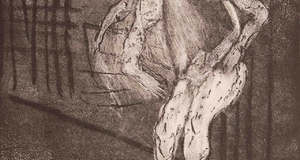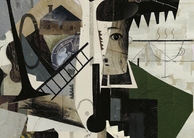Abu Ghraib, Homonationalism, and the Rationalization of Modern Torture
By
2020, Vol. 12 No. 09 | pg. 1/1
IN THIS ARTICLE
KEYWORDS
AbstractDrawing on Jasbir Puar’s analysis of homonationalism in the post-9/11 United States, I investigate the Orientalist and Islamophobic discourses present in liberal and LGBTQ news articles and human rights reports responding to the release of torture photos from Abu Ghraib prison in May 2004. This study looks at how Western journalists and human rights organizations from diverse political and social identifications bolstered the homonationalist project in their responses to torture at Abu Ghraib. In doing so, it reveals homonationalism as a discourse with multiple iterations that differ across the varied archive of LGBTQ and liberal journalism and human rights reports. The prevalence of homonationalist, Orientalist, and Islamophobic discourses in Western journalism and human rights reports in the aftermath of Abu Ghraib demonstrates a shared inability to confront the constitutive role of sexualized violence in the service of US colonial power. On April 28th, 2004, a news report on the CBS segment 60 Minutes II brought to American television audiences the first publicly available images of sexual torture by American soldiers at Abu Ghraib prison outside of Baghdad (Leung, 2004). Widely known for horrific abuses committed there in the era of Saddam Hussein, Abu Ghraib fell to American troops during the 2003 invasion, whereupon Americans renovated the prison and reopened it as a detention center for suspected terrorists. Of several thousand prisoners who inhabited the US military prison, most “were civilians, many of whom had been picked up in random military sweeps and at highway checkpoints” (Hersh, 2004). Little was known about what took place inside. That changed abruptly on April 28th, when vivid images of prisoner abuse at Abu Ghraib, taken by American prison guards in Iraq, were broadcast. Photos graphically displayed Iraqi prisoners forced into sexually humiliating positions, many of them with strong homosexual implications. The images “rocketed around the world” and international news and media exploded with commentary on the American torture scandal (Leung, 2004). In a war promoted as the Western “liberation” of women and other marginalized individuals from monolithically oppressive Islamic cultures (Chen, 2004), images of American soldiers forcing Muslim men to strip and “simulate gay sex acts as a form of abuse and humiliation” shocked the American public (Dahir, 2004).The ensuing burst of responses in Western media and news outlets displayed a vast array of reactions, ranging from outrage to disbelief to approval. In an anonymously authored opinion article in LGBTQ news source The Guide in June 2004, the author contrasts the relatively “apolitical, non-confrontational” nature of that month’s Pride celebration and the apparent retreating of “cruder forms of homophobia” in American society with the photographic evidence of homophobic humiliation emerging out of Iraq (“Prisons’,” 2004). Entitled “Prisons’ Pride Lessons,” the article states that “homosexuality is, in many contexts, more accepted and gay people less brutally treated than even just a few years ago. We're here. We're queer. And people are getting used to it” (“Prisons’,” 2004). However, the author writes, “Photos from the US prison at Abu Ghraib in Iraq underscore how homosexuality is still regarded by many as the most heinous, despicable degradation imaginable” (“Prisons’,” 2004). The author struggles to reconcile the apparent recent social advancements of gay citizens within the US with the use of homosexual acts as a mode of torture by the American military in Iraq. They conclude the article by stating that gay Americans should reflect on the still unchallenged nature of certain “destructive notions” about homosexuality in America in order to “make this year's gay pride more meaningful” (“Prisons’,” 2004). This desire to emphasize the ways in which LGBTQ Americans have experienced social advancement in the US, even despite the blatantly homophobic realities of the war in Iraq, can be understood as an example of Jasbir K. Puar’s concept of homonationalism. In her influential book Terrorist Assemblages (2017), Puar argues that forms of American exceptionalism highlighted by the US in recent decades have attempted to justify the War on Terror by showing that Americans are willing to embrace women and queer citizens, while terrorists are not. She states that current forms of exceptionalism “work or are furthered by attaching themselves to, or being attached by, nonheterosexual, homonormative subjects” (Puar, 2017, p. 4). Thus, her theory of sexual exceptionalism exposes how and why “homosexual subjects who have limited legal rights within the U.S. civil context gain significant representational currency when situated within the global scene of the war on terror” (Puar, 2017, p. 4). Puar argues that the post-9/11 narrative of American nationalism involved an “uneasy yet urgent folding in of homosexuality into the ‘us’ of the ‘us-versus-them’ nationalist rhetoric” (Puar, 2017, p. 43). Within the formulation of homonationalism and US sexual exceptionalism post-9/11, a “Muslim or gay binary” emerged, in which it was assumed that no respectable queer Muslims could exist (Puar, 2017, p. 19). In contrast, the Muslim terrorist was always perversely sexualized. Puar states that these assumptions fed into colonial Orientalist fantasies of Muslim sexual excess and perversion, wherein “the proper modern gay or lesbian Muslim subject is foreclosed, while the terrorist is forever queer, improperly sexual, embedded in an ‘always already homosexualized population’” (Puar, 2017, p. 14). In the aftermath of the Abu Ghraib torture scandal, as many American political commentators, news sources, and human rights organizations struggled to respond to and come to terms with the photographs, patterns of disavowal of the torture began to emerge. The homonationalist work performed by Western journalists and human rights organizations in response to torture at Abu Ghraib served to justify, disavow, and exceptionalize torture, leaning heavily on civilizational discourses to place blame on Iraqi victims for their own abuse. This study looks at how Western journalists and human rights organizations from diverse political and social identifications have bolstered the homonationalist project in their responses to torture at Abu Ghraib. In doing so, it reveals homonationalism as a discourse with multiple iterations that differ across the varied archive of LGBTQ and liberal journalism and human rights reports. While homonationalism is presented by Puar as primarily within the purview of LGBTQ Americans, I suggest that a lack of acknowledgement of the homosexual realities of the torture by liberal journalists and human rights reports represents a unique form of homonationalism, similarly powerful in its ability to paint a profoundly false morally and sexually exceptional image of the United States. The prevalence of homonationalist, Orientalist, and Islamophobic discourses in Western journalism and human rights reports in the aftermath of Abu Ghraib torture demonstrates a shared inability to confront the constitutive role of sexualized violence in the service of US colonial power. Although in the aftermath of the photo scandal, many American journalists expressed their horror at the photos coming out of Iraq and at the actions of the Bush Administration, it quickly became clear that even those liberal commentators who professed consternation had a stake in maintaining America as the moral authority on human rights, and upholding humanitarian justifications for the war. Even LGBTQ Americans, responding to the use of gay sex as a form of torture in Iraq, frequently displayed nationalistic tendencies. The publication of photos of torture at Abu Ghraib forced Americans from diverse political persuasions and social identifications to confront the violence being enacted abroad in their name and many were publicly more invested in maintaining the illusion of US morality than in broadly condemning and accepting responsibility for violence. MethodologyMy research for this project is grounded in close textual analysis of Western news articles and human rights reports. I looked to LGBTQ media sources such as The Guide, The Gay & Lesbian Review, and The New York Blade. Additionally, I analyzed liberal news articles primarily in The Guardian, The Atlantic, and The New York Times. I analyzed articles published between 2004 and 2009 and focused on opinion pieces that both displayed clear political leanings and made sweeping assertions about “Muslim culture” or the “reasoning” behind American torture in Iraq. In my analysis of human rights responses, I drew on publications from Human Rights Watch, Amnesty International, and the American Civil Liberties Union. I chose reports that addressed torture at Abu Ghraib most explicitly and directly, analyzing the specific language the organizations used, both in exposing how and why the torture took place and in calling on the Bush Administration to respond to the actions of American soldiers. Overall, I reviewed approximately 200 articles and reports. My approach to this archive was to track the use of subtly disavowing, scapegoating, and victim-blaming rhetoric. The disavowal exhibited by journalists and human rights organizations often took the form of exceptionalizing the events at Abu Ghraib and making it appear that such tactics of sexual violence were a shocking, momentary blip in an otherwise exemplary American human rights track record. Many journalists also extrapolated about the ways that the exceptional brutality and sexual perversion of Islam compelled US soldiers to behave exceptionally in return. I also looked for places in which the authors did not acknowledge the homosexual implications of the torture at Abu Ghraib. Although the acknowledgement and labeling of “gay sex” in the context of the torture of Iraqis has been controversial, I view these moments of ignoring sexuality as tacitly bolstering the homonationalist project, which in part works to quell any accusations of homophobic foreign policy enacted by the US government. Many liberal news articles and human rights reports referred to the torture without engaging whatsoever with its homosexual implications. By not publicly pointing out the homophobic nature of the humiliation endured by Iraqi prisoners at the hands of American soldiers, the US is able to maintain its image as a sexually free and accepting place, and therefore morally superior to a monolithically oppressive and sexually perverse Iraq. This, in turn, perpetuates the justification of the war overall. Across the spectrum of media I analyzed, I observed a wider and more nuanced range of homonationalism than Puar explicitly explores in Terrorist Assemblages. The disavowal of homophobic American violence present in LGBTQ media in the aftermath of the Abu Ghraib scandal clearly represents the most direct bolstering of the homonationalist project. However, liberal outlets also engaged with homonationalist logics, albeit in less explicit ways. In these cases, it is often an unwillingness to confront the homosexual implications of the torture which actually perpetuates homonationalism. Although liberal journalists sometimes commented on the homosexual nature of the torture, they almost always did so in a way that pointed to the sexual perversion of the Muslim prisoners. This refusal to acknowledge the obviously homophobic nature of American foreign policies at play demonstrates a distinct form of homonationalism. Human rights reports, like liberal media, often bolster the homonationalist project by refusing to name the blatant homophobia demonstrated at Abu Ghraib. Human rights reports lean on orientalist, imperialist, and civilizational discourses in order to “explain” and analyze the torture employed at Abu Ghraib. As Puar argues, these discourses all carry with them heavily sexualized colonial histories, in which differentiation and hierarchization are often based in judgements of sexual perversion. In this paper, I take a critical approach to the project of human rights, along the lines of Inderpal Grewal (1999) and Pheng Cheah (2007). My analysis of homonationalist discourses in human rights responses to torture at Abu Ghraib aligns itself with transnational feminist critiques of human rights as a universal project. This project contributes to a greater understanding of both how homonationalism has become a constitutive element of Western discourse on the War on Terror, and how Westerners have relied on Islamophobic and Orientalist rhetoric to continue to justify American military intervention in the Middle East, even when that intervention includes the torture of civilians. Colonial Legacies of Orientalism and IslamophobiaIn looking at the sexualization of Muslim men in the modern setting of Abu Ghraib, it is imperative to understand the history of Orientalism in the West and how the Middle East has been viewed as a locus of sexual perversion for centuries. In this review of literature, I draw on sources that analyze sexual politics in a variety of Middle Eastern and North African nations, not just Iraq, as the specificity of Iraq’s political and social history is often lost on mainstream Western media. In her book, Islamophobia and the Politics of Empire (2012), Deepa Kumar addresses the myth of Islam as a “monolithic religion,” arguing that “it is often taken for granted that Islam is homogenous” (Kumar, 2012, p. 42). This denial of cultural, political, social, and religious complexity enables Westerners to “argue that Islam has certain inherent, unchanging characteristics that render it antidemocratic, violent, sexist, and so on” (Kumar, 2012, p. 42). One of those characteristics is rampant homophobia. In Edward Said’s canonical book, Orientalism (1978), he explores the ways in which the people of the “Orient” have represented, for thousands of years, one of Europe’s “deepest and most recurring images of the Other” (Said, 1978, p. 1). Said argues that for centuries, the production of Orientalist knowledge has acted “as a Western style for dominating, restructuring, and having authority over the Orient,” (Said, 1978, p. 3) and has helped “define Europe (or the West) as its contrasting image” (p. 2). Within that Western Orientalist discourse, the perceived sexual perversion of Oriental individuals has long been a given. One origin of Oriental sexual threat, identified by Said, is the perceived challenge to Christianity by Islam and by the figure of the Prophet Mohammed in the 1st century. Said states that “since Mohammed was viewed as the disseminator of a false Revelation, he became…the epitome of lechery, debauchery, sodomy, and a whole battery of assorted treacheries” (Said, 1978, p. 62). The figure of the modern terrorist fits neatly into this trope, as religious extremism and expressions of violence toward the West fall in line with perceived Muslim threats against the West over the past 2000 years. Within this context, Puar argues, the modern terrorist is “forever…improperly sexual” (Puar, 2017, p. 14). In her highly influential book Imperial Leather (1995), Anne McClintock also reflects on the perverse sexualization of non-Western individuals, particularly by Western male travelers. She begins her book by mapping “male travel as an erotics of ravishment” (McClintock, 1995, p. 22). She argues that “for centuries, the uncertain continents—Africa, the Americas, Asia—were figured in European lore as libidinously eroticized. Travelers’ tales abounded with visions of the monstrous sexuality of far-off lands” (McClintock, 1995, p. 22). Unfamiliar continents became spaces of adventure “onto which Europe projected its forbidden sexual desires and fears” (McClintock, 1995, p. 22). This European rhetoric shows the fundamental connections between imperialist ventures and the aberrant sexualization of native populations. In more recent periods, Orientalist assumptions about the sexual practices and prejudices of Muslim communities have led to new forms of Islamophobic Orientalism, in which Western nations have cast themselves as sexually free and accepting in contrast to the Middle East’s uncomplicated, ahistorical homophobia and violent sexual oppression. As Lila Abu-Lughod argues in her essay “Do Muslim Women Really Need Saving?” (2002), “cultural framing” that locates the origins of violence and oppression within Islam—rather than looking at the destabilizing impact of Western colonialism in the Middle East and past American financial backing of modern terrorist organizations—perpetuates the assumption that America is morally superior and has a right to “liberate” the people of Iraq through military intervention (Abu-Lughod, 2002, p. 784). In her essay “Emotional Attachments and Secular Imaginings: Western LGBTQ Activism on Iran” (2013), Mitra Rastegar explores the ways in which Islam, in the “secular imagination,” is prone to “uniquely irrational and anti modern violence” (Rastegar, 2013, p. 2). This is particularly true in the case of perceived homophobic persecution in places like Iran, where Western assumptions about the violence enacted to oppress sexual freedoms give rise to an “essentialized ‘civilizational’…divide between a violently intolerant ‘Islam’ and a progressively more tolerant ‘West’” (Rastegar, 2013, p. 2). Muslims are seen as universally the inheritors and perpetuators of a backward, violent system that is fundamentally incompatible with “Western values” of freedom and acceptance. Digging into the Western media response to the execution of two teen boys in Mashhad, Iran in 2005, Rastegar asserts that instances of violence in Iran are often misinterpreted or explicitly manipulated by Western media, which capitalizes on examples of alleged anti-gay violence in order to justify Islamophobic rhetoric. Although tolerance of gay sex and LGBTQ people has been a relatively recent development in the US, Americans have wasted no time in mobilizing claims to moral superiority and as justification for waging war. Joseph Massad, in his book chapter “Re-Orienting Desire: The Gay International and the Arab World” (2008), explores how the Middle East has also long been a space of imagined sexual adventure for gay Westerners. Despite this perception of Middle Eastern nations as being permanently at war with sexuality, Orientalist notions of sexual excess in the Middle East have never ceased to captivate Western audiences. In addition to exploring the impacts of Western LGBTQ “activism” in Egypt, Massad discusses the projection of Western male sexual desire onto Middle Eastern nations like Egypt. He states, “as Jeffrey Weeks informs us, ‘many Western gays, for a long time now, have traveled hopefully to the Muslim world and expected to find sexual paradise’” (Massad, 2008, p. 165). Because “Western Christian propaganda had for centuries portrayed Muslim societies as immoral and sexually licentious compared to Christian morality,” powerful associations remain between the Middle East and a kind of erotic permissiveness (Massad, 2008, p. 165). This belief is a modern iteration of McClintock’s colonial-era understanding of “male travel as an erotics of ravishment” and the projection of Western male sexual desires onto “foreign” and “exotic” lands. This contradiction between assertions of brutal sexual oppression in the Middle East and perceptions of Middle Eastern nations as erotic paradises very aptly illustrates the history of Orientalist thought: Arab and Muslim subjects are viewed as being “sexually lascivious and excessive, yet perversely repressed” (Puar, 2017, p. 20). In the War on Terror, these contradictory Western assumptions about Muslim sexuality are not only the premise for LGBTQ activism or gay tourism, but are also the context for military invasion and occupation. The belief that Muslim men and women are both pathologically sexually repressed and perversely over-sexualized provides the libidinal landscape for the War on Terror, in which tactics of sexual torture and humiliation are employed to punish alleged terrorists and then are blamed on the victims. These beliefs also give rise to the project of homonationalism, in which respectable Western gays are absorbed into mainstream American society in order to promote the West as morally superior to the Middle East. In the following section, I explore the ways in which Orientalist and colonial assumptions have infused not only Western discourses about sexuality, but also the seemingly objective and progressive realm of human rights. Transnational Feminist Critiques of Human RightsHuman rights emerged as a prominent post-World War II discourse that gained political significance as the US expanded its global empire and extensively interfered in Middle Eastern and other international affairs. Throughout the 20th century human rights became a benchmark of modernity, espousing the belief that all humans in the world are equally deserving of certain basic rights. Transnational feminist scholars have critiqued this assumption of universality, noting instances when interventionist powers like the United States have leaned on human rights as a guise for pursuing economic interests. In her essay, “‘Women's Rights as Human Rights’: Feminist Practices, Global Feminism, and Human Rights Regimes in Transnationality” (1999), Inderpal Grewal addresses this intertwining of human rights and financial and civilizational motives:
While the project of universal human rights is based on the fallacy that there exists an international community of equals, in which nations can hold each other equally accountable, this imagined community is realistically composed of a few (Western) global superpowers who call out less powerful nations on their human rights violations in order to justify intervention, continue the work of capitalist globalization, and often cover up human rights abuses of their own.2 In her essay, “Decolonizing the ‘Universal’ Human Rights Regime: Questioning American Exceptionalism and Orientalism,” Hakimeh Saghaye-Biria argues that “the drawing up of a universal declaration of human rights in essence results in the rationalization, institutionalization, and universalization of the hierarchical view of the world in terms of a superior West against inferior others” (Saghaye-Biria, 2018, p. 63). Like homonationalism, this logic of universal human rights can be mobilized to justify US intervention in Iraq, and the violence, including torture, that comes along with it. Human rights discourse around torture is particularly laden with civilizational assumptions. In Talal Asad’s article “On Torture, or Cruel, Inhuman, and Degrading Treatment” (1996), Asad reflects on the associations that exist between torture as a mode of discipline and “primitive” societies. He argues that “the modern history of ‘torture’ is…part of a more complex story of the modern secular concept of what it means to be truly human” (Asad, 1996, pp. 1081–1082). Often, the very notion of torture serves as a “cross-cultural criterion for making moral and legal judgements about pain and suffering” (Asad, 1996, p. 1082). Asad reflects that because physical cruelty is seen as “a feature of barbaric societies––that is, societies that have not yet been humanized,” the West has a strong interest in publicly distancing itself from practices of torture in an effort to maintain the guise of superior civilization (Asad, 1996, p. 1083). As Grewal asserts, human rights discourses rely on “universalized notions of what it means to be human and what rights accompany this humanity” (Grewal, 1999, p. 340). Because of this, the human rights project has often been used as a tool of differentiation between the civilized West and the uncivilized “other.” The Rationalization of Modern TortureAttempts to distance Abu Ghraib torturers from the rest of America, while simultaneously blaming Iraqi victims for the forms of sexual humiliation used to torture them, have been employed widely in American media and human rights reports. Although there has been some variation in tactics used by journalists from different parts of the political spectrum, the impulse to deny, diminish, and disavow sexual torture at Abu Ghraib has been widespread. In my research, I explore LGBTQ and liberal media and human rights reports responses to the Abu Ghraib photos and analyze the ways these sources consistently disavow torture in Iraq in an attempt to maintain the nationalist illusion of American moral superiority over Middle Eastern nations. LGBTQ MediaLGBTQ news sources often exhibited this trend of disavowal and victim blaming in their responses to torture at Abu Ghraib. Although some LGBTQ journalists recognized the photos that came out of Abu Ghraib as representative of a more insidious American culture of homophobic violence, those same articles often still placed blame on Iraqi victims for their own humiliation. In one such article, published in Newsday and entitled “Gay sexuality shouldn’t become a torture device” (2004), gay-identified writer Patrick Moore at times expresses sentiments that contextualize the actions of American troops in Iraq within American cultures of homophobia. He states that American “squeamishness about gay sexuality can’t be ignored,” and argues that a “healthier attitude [toward sex in America] might actually help avert such perversions as have been employed in Iraq” (Moore, 2004). However, he also argues that “the humiliating techniques…are particularly effective because of Islam’s troubled relationship with homosexuality” (Moore, 2004). He even goes so far as to quip that “it seems the Bush administration has finally taken the time to understand a key Islamic belief” (Moore, 2004). Although Moore intends to remark upon the cultural incompetency of the Bush administration, he also clearly states that homophobia is fundamental to Islam, therefore, again, doubling down on explaining torture at Abu Ghraib on the grounds that it exploits prejudice against gays that is inherent to Islam, not to the US. In this article, Moore leans heavily on Islamophobic and Orientalist assumptions in order to subtly blame the victims for their own torture. Michael Luongo, writing for The Gay & Lesbian Review, took a somewhat novel tactic in his response to Abu Ghraib. Instead of trying to directly disavow the American legacy of torture, he went on a journalistic mission in the aftermath of the torture scandal, hoping to prove that Iraqi society is not as homophobic as believed in the West. In his article, “Islamic War Zones I Have Visited” (2008), Luongo details his wartime visits to Iraq and Afghanistan as a gay man, intending to investigate the existence and scope of “gay” culture in the Middle East. Luongo sets out in typical colonial fashion, with the intention of investigating the essentialized “other” and offering an assessment of the degree of Iraqi civilization by measuring it against Western standards. As explained by Abu-Lughod (2002), Luongo frames homophobia as a problem centered within Iraq, rather than reflecting on the manifestation of homophobia in the US. By embarking on this project, he implicitly gives credence to American assumptions about Iraq as a locus of homophobia, and therefore to the use of Iraqi homophobia as a justification for homosexualized torture perpetrated against Iraqi prisoners. Luongo uses cultural framing to locate homophobia in Iraq, rather than exploring how the US is implicated in Middle Eastern politics and in the actions of American soldiers.3 This allows for further disavowal of the US’ role in perpetuating violence. In addition, by providing somewhat lurid examples of gay expression he encountered in Iraq and Afghanistan, he reinforces orientalist tropes about Middle Eastern nations as loci of sexual perversion. In one instance in Afghanistan, he relates,
This is a prime example of the projection of Western gay sexual fantasies that Joseph Massad discusses. In this instance and others throughout the article, Luongo perpetuates beliefs about the sexual permissiveness of Middle Eastern societies, which continue to draw on colonial era assumptions about the sexual perversion of Muslim men. By explicitly locating this instance of public sexual expression directly in front of “one of the holiest shrines in all of Islam,” Luongo draws on centuries-old associations between Islamic religious ritual and sexual excess/perversion. Although he ostensibly sets out to undermine American justifications of torture and scapegoating of Iraqi victims by demystifying “gay” life in Iraq, Luongo’s article both validates those assumptions and reinforces Western beliefs about the sexual aberrance of Muslim men. Luongo’s stated use of an Arabic translator on these trips also calls into question the authenticity of his exchanges, as Western travel narratives of the “Orient” throughout history have been notoriously riddled with destructive misunderstandings. These two articles by gay American men represent the most direct evidence of homonationalism at work. Although in these examples neither journalist explicitly supports the War on Terror, the alignment of LGBTQ journalists with the American nationalist project of distinguishing itself from the immorality, sexual perversion, and excessive violence of the Middle East serves to further emphasize the superiority of the West. This is the most explicit form of homonationalism, as described by Puar (2017). By writing articles such as these, which subtly point to the backwardness of Iraqi culture and society, Western gays are upholding the underlying logics that continue to justify the war. Liberal JournalismAlthough (non-LGBTQ) liberal journalists do not represent the same direct form of homonationalism exhibited by the Western gay community, they still have a significant interest in promoting the US as morally and sexually superior, and therefore engage in a homonationalist disavowal of American torture by leaning on sexually charged civilizational discourses. Liberal journalists often attempted to take broad national responsibility for the torture at first, but their articles quickly dissolved into disavowal and victim blaming. In one article, published in The Guardian in May 2004, entitled “Torture as Pornography,” British historian Joanna Bourke exemplifies subtle attempts by liberal Westerners to distance themselves from the torturers at Abu Ghraib. Bourke argues that the torture there was an “enactment of comradeship between men and women who are set apart from civilian society back home” (Bourke, 2004). By suggesting that the soldiers were compelled to behave violently because of their distance from “civilian” society in the west, Bourke implies that had the soldiers been properly situated within American society, they would never have been inclined to torture. This logics rests on the assumption that proximity to American society would have prevented such heinous acts of violence. Conversely, their proximity to Iraqi society compelled the soldiers to abuse prisoners. Bourke thus reignites the Orientalist discourse that counterposes “civilized” American and “backward” Islamic societies. Further along in the article, Bourke goes so far as to say that the “sexual nature of these acts shows that the torturers realize the centrality of sexuality for their victims’ identity” (Bourke, 2004). Here, Bourke places blame for the actions of American soldiers onto the shoulders of their Iraqi victims, stating that the torturers committed acts of sexualized torture because they knew that those acts would be particularly effective on Muslim prisoners. In other words, the American soldiers employed sexual torture, not because they were expressing their own cultural understandings of and judgements about sexuality, but because they believed that their Iraqi victims would be traumatized by the cultural implications of same-sex physical contact. This entirely lets the American soldiers off the hook for having employed such heinous mechanisms of torture, and mobilizes an Islamophobic script that places blame on the victims for bringing forth sexually violent impulses in their guards. Similarly, an article by Mark Bowden for The Atlantic, entitled “Lessons of Abu Ghraib” (2004), attempts to downplay the violence committed by American soldiers at Abu Ghraib by highlighting abuses perpetrated by Iraqi prison guards and Islamic extremists. He asks, suggestively, “Maybe it's just me, but did I miss a similar storm of moral outrage from the Arab world over the pious Islamists who got out their video cameras to record the gruesome beheadings of Daniel Pearl and Nicholas Berg?” (Bowden, 2004). In the same vein, he states,
Bowden’s disturbingly dismissive rhetoric employs sweeping assumptions about the inherent brutality of Iraqi society, belittling the experiences of Iraqis tortured by American soldiers on the grounds that they would have been treated much worse by their own law enforcement. This characterization of Iraq as inherently backward and indiscriminately violent feeds into rhetorics of American exceptionalism and draws on Mitra Rastegar’s (2013) understanding of a presumed irreconcilable “civilizational” divide between America and the Middle East. Bowden attempts to place scrutiny on the actions and “culture” of Iraqi prisoners at Abu Ghraib, rather than engaging thoughtfully with the Western Islamophobic and homophobic violence visible in the photos. Following Lila Abu-Lughod (2002), I argue that this rhetoric, present in many similar liberal media responses to Abu Ghraib, uses cultural framing to draw heavily on colonial discourses of Orientalism, in which the locus of sexual perversity and excess is always firmly situated in the Middle East. Thus, the assumptions about Muslim torture victims made by Bourke, Bowden, and other liberal journalists locate sexual intolerance, repression, and perversion within the context of Islam and subvert questions about how American cultural assumptions and prejudices about sexuality contribute to the use of sexualized torture methods. This draws explicitly on Puar’s understanding of the Muslim terrorist as always “perversely sexualized,” in comparison to the respectable American gay citizen, and leans on homonationalist discourses of Western moral and sexual superiority (Puar, 2017, p. 38). The noticeable absence of any mention of the homosexual implications of the torture at Abu Ghraib in many liberal news sources responding to the photographs illustrates a kind of indirect bolstering of the homonationalist project. In Terrorist Assemblages (2017), Puar argues that discussions of gay sex in the context of torture at Abu Ghraib are counterproductive: “saying that the simulated and actual sex scenes replicate gay sex is an easy way…to disavow the supposedly perverse proclivities inherent in heterosexual sex and the gender normativity immanent in some kinds of gay sex” (Puar, 2017, p. 97). Focusing on the “gayness” of the torture at Abu Ghraib perpetuates Orientalist assumptions about Islam’s troubled relationship with homosexuality and places more emphasis on the shocking nature of the torture than on the abomination of the torture’s very occurrence. After both Gayle Rubin and Katherine Franke, Puar argues that “‘over-eroticizing’” assaults is dangerous in that it draws attention away from the underlying power structures that enable such an assault (Puar, 2017, p. 112, quoting Katherine M. Franke). The sex is not the problem; the problem is that the violent acts were allowed to happen in the first place. Therefore, Puar believes that “the terms ‘scandal,’ ‘sexual,’ and ‘abuse’ need to be semiotically discharged” from discussions of Abu Ghraib torture (Puar, 2017, p. 112). While I cannot disagree with the logic of this claim, I argue that there is a delicate balance between not burdening sexual torture with “‘an excess of significance’” and completely ignoring the homophobic implications of US foreign policy in the War on Terror (Puar, 2017, p. 97, quoting Gayle Rubin). Part of the work performed by homonationalism is that it precludes any accusations of homophobia perpetrated by the US government. By not calling out the homophobic nature of the torture executed by American soldiers in Iraq, American media sources indirectly bolster justifications for the American invasion of Middle Eastern nations, which are conceived as being brutally homophobic and backward in contrast to the secular liberal progressiveness of the West. If journalists were to examine the homophobic origins of the actions of Americans in Iraq, it might be difficult to maintain the illusion of American superiority on the basis of its pro-LGBTQ stance. Because of this, it is dangerous to state absolutely that references to “gay sex” should be discharged from all discussions of torture at Abu Ghraib. While these references can certainly be misused with attention-grabbing, shock-inducing, sensationalistic intent, I argue that it is equally perilous to ignore and erase the homophobic implications of US foreign policy, and the way homophobic violence has been mobilized to cement colonial power structures for centuries. Human Rights ReportsMajor human rights organizations and international governmental bodies responded to torture at Abu Ghraib in a more direct fashion than mainstream US news sources. Despite this, their impulse to locate the root of the problem in legal loopholes exploited by the US government marks their own wish to avoid recognition of the widespread use of torture in America. The desire to trace “how this happened” from a legal standpoint makes the events at Abu Ghraib seem exceptional; it implies that for the most part the protections of the Geneva Convention, the US Constitution, and other preventative bodies keep people from torturing, but in this unique instance the Bush Administration found a way to dodge protocol. Although many look to organizations like Human Rights Watch (HRW) to inform them objectively about human rights abuses around the world, it must be recognized that HRW and similar organizations remain embedded in the Western enterprise of justifying imperialism. In multiple HRW reports in the years after the release of photos from Abu Ghraib, the so-called “road to Abu Ghraib” is loosely tracked (Brody, 2004). One major HRW report, published just weeks after the release of the photographs, argues that the “pattern of abuse…resulted from decisions made by the Bush administration to bend, ignore, or cast rules aside” (Brody, 2004). The report also states that by circumventing legal protections for prisoners of war, the Bush Administration ignored “the deeply rooted U.S. military practice of applying the Geneva Conventions broadly” (Brody, 2004). This report by HRW and other persistent attempts to locate legal loopholes served to exceptionalize the tactics of torture used at Abu Ghraib and assert that the treatment of prisoners in the Iraq War is a shocking break with traditionally civilized American warfare. So much focus and attention is placed on one instance and how it happened that human rights theorists and the general public are able to ignore the ways in which this kind of sexualized, racialized torture is foundational to the maintenance of colonial power hierarchies in American society and beyond. In similar fashion, a letter from the directors of the ACLU to the Bush administration in 2004 stated, “the abuses are the sadly predictable result of detention policies pursued by your Administration…that do not honor the rule of law or American values” (Romero et al., 2004). Although this letter to President Bush extensively details and condemns the violations committed by American troops in Iraq and the actions of the American government in circumventing protections for prisoners, it falls back on the assumption that these behaviors do not reflect “American values,” but rather represent an aberration in American foreign policy. Then-Acting UN High Commissioner Bertrand Ramcharan expressed a similar sentiment: “‘Everyone accepts the good intentions of the coalition governments as regard the behavior of their forces in Iraq…there have sadly been some violations of human rights committed by some coalition soldiers’” (Hoge, 2004). Both sources take for granted the good American intentions that underlie their “slip-up.” This contributes to the painting of Abu Ghraib as an exception, overlooking the US’ centuries-long legacy of racialized, sexualized torture. These assumptions of US superiority and moral intentions, even in the face of blatant civilian torture, explicitly draw on the Orientalist binarization of the civilized West and uncivilized East, which has in many ways been codified by the project of universal human rights. Saghaye-Biria argues that “Orientalism and Eurocentrism together play as the grand narrative of human rights creating unequal power relations between the countries of the West, most importantly the United States, and the Oriental other countries” (Saghaye-Biria, 2018, p. 66). As scholars such as Puar, Said, and McClintock demonstrate, these colonialist, Orientalist narratives of Western superiority are often laden with assumptions of sexual perversion and excess. Thus, the inherently civilizational and universalizing rhetoric of the human rights project is implicitly tied to the sexually burdened Orientalist discourses of homonationalism and the Western project of asserting moral superiority over Middle Eastern nations. Human rights reports, like liberal journalism on Abu Ghraib, varied in their references to homosexuality when discussing torture in the photographs. I argue, again, that by not naming the homophobic nature of the torture at Abu Ghraib, human rights investigators tacitly bolster the homonational project by allowing American homophobia to go unchecked. An Amnesty International report from 2006, entitled Beyond Abu Ghraib: Detention and Torture in Iraq, refers to the photographs as “showing inmates being tortured and humiliated by US guards” (Beyond Abu Ghraib, 2006).4 While objectively true, this sentence shows no recognition of the centuries of Western homophobic colonial oppression toward which these photographs explicitly gesture, and therefore indirectly maintain the underlying logics of homonationalism by precluding any acknowledgement of the ongoing, homophobic civilizational practices mobilized by the US in the War on Terror. Although homonationalism may not be apparent in its most explicit form in the context of human rights reports, human rights advocacy rests on centuries of imperialist discourse, which itself is founded in moral judgements of sexual perversion and civilizational differences. Conclusion: Homonationalism and Modern TortureIn Civilizing Torture: An American Tradition (2018), W. Fitzhugh Brundage tracks the history of debates about the use of torture throughout American history. Brundage notes that “since the nation’s founding, Americans have boasted that the United States is a unique nation with uniquely humane laws and principles” (Brundage, 2018, p. 3). Despite this, torture has consistently been employed in US prisons and international conflicts for centuries. These many instances of torture have almost always been framed and debated within discourses of American exceptionalism. Thus, the “historical study of American torture necessarily catalogs not only acts of violence but also the explanations, justifications, and denunciations of them” (Brundage, 2018, p. 6). Despite these various responses, the use of torture has continued and assumptions about both the civility of American society and the culpability of torture victims have “enabled many Americans to retain their faith in the nation’s innate innocence” (Brundage, 2018, p. 11). This essay has tracked the work of disavowal and justification carried out by LGBTQ and liberal media sources and human rights reports in the wake of the Abu Ghraib torture scandal. Across the US political spectrum, homonationalist logics bolstered assertions of American moral and cultural superiority over Iraq. Journalists and human rights organizations relied on the rhetoric of American exceptionalism in their attempts to minimize the events at Abu Ghraib. Minimization, exceptionalization, and victim-blaming enabled a politically and socially diverse sampling of actors to rationalize the ongoing American occupation of Iraq. My research has demonstrated that even in the context of a scandal that shocked the nation, few Americans were willing to publicly confront the ways that homophobic violence and torture are constitutive of American society and imperial power. The reactions of the liberal and LGBTQ media and human rights organizations served to distance Americans further from Iraqi civilians and the violence perpetrated against them. News articles and human rights reports that did not reference the homosexual implications of the torture helped to foreclose any discussion of homophobic US foreign policy by leaving it unacknowledged. Despite the revelation of exceptionally damning, government-sanctioned torture in the US War on Terror, the continued homonationalist justifications for the war in Iraq showed that many citizens in the US were willing to turn a blind eye toward violence perpetrated against others in their name. The consistent disavowal of US torture and the mobilization of Orientalist and Islamophobic discourses by Western journalists and international human rights organizations demonstrated widespread investment in continuing to defend the US invasion of Iraq, and in perpetuating homophobic civilizational discourses that reflect centuries of colonial violence. ReferencesAbu-Lughod, L. (2002). Do Muslim Women Really Need Saving? Anthropological Reflections on Cultural Relativism and Its Others. American Anthropologist, 104(3), 783–790. Asad, T. (1996). On Torture, or Cruel, Inhuman, and Degrading Treatment. Social Research, 63(4), 1081–1109. Beyond Abu Ghraib: Detention and Torture in Iraq. (2006). Amnesty International. Bourke, J. (2004, May 7). Torture as pornography. The Guardian. https://www.theguardian.com/world/2004/may/07/gender.uk Bowden, M. (2004, July 1). Lessons of Abu Ghraib. The Atlantic. https://www.theatlantic.com/magazine/archive/2004/07/lessons-of-abu-ghraib/302980/ Brody, R. (2004, June 8). The Road to Abu Ghraib. Human Rights Watch. https://www.hrw.org/ report/2004/06/08/road-abu-ghraib Brundage, W. F. (2018). Civilizing Torture: An American Tradition. Harvard University Press. Cheah, P. (2007). Posit(Ion)Ing Human Rights in the Current Global Conjuncture. In Inhuman Conditions: On Cosmopolitanism and Human Rights (pp. 145–177). Harvard University Press. Chen, E., & Reynolds, M. (2004, March 13). Bush Says War on Terror Led to Women’s Freedom. Los Angeles Times. https://www.latimes.com/archives/la-xpm-2004-mar-13-na-bush13-story.html Dahir, M. (2004). Gay Sex and Prison Torture in Iraq War. New York Blade, 6(13), 19. Grewal, I. (1999). Women’s Rights as Human Rights’: Feminist Practices, Global Feminism, and Human Rights Regimes in Transnationality. Citizenship Studies, 3(3), 337–354. Hersh, S. M. (n.d.). Torture at Abu Ghraib. The New Yorker. https://www.newyorker.com/magazine/2004/05/10/torture-at-abu-ghraib Hoge, W. (2004, June 4). U.N. Says Abu Ghraib Abuse Could Constitute War Crime. The New York Times. https://www.nytimes.com/2004/06/04/international/middleeast/un-says-abu-ghraib-abuse-could-constitute-war-crime.html Kumar, D. (2012). Islamophobia and the Politics of Empire. Haymarket Books. Leung, R. (2004, May 5). Abuse At Abu Ghraib. CBS News. https://www.cbsnews.com/news/ abuse-at-abu-ghraib/ Luongo, M. (2008, March 1). Islamic War Zones I Have Visited. The Gay & Lesbian Review. https://glreview.org/article/article-47/ Massad, J. A. (2008). Re-Orienting Desire: The Gay International and the Arab World. In Desiring Arabs (pp. 160–190). University of Chicago Press. McClintock, A. (1995). The Lay of the Land: Genealogies of Imperialism. In Imperial Leather: Race, Gender, and Sexuality in the Colonial Contest (pp. 21–74). Routledge. Moore, P. (2004, May 7). Gay sexuality shouldn’t become a torture device. Newsday Prisons’ Pride Lessons. (2004). The Guide, 24(6), 6. Puar, J. K. (2017). Terrorist Assemblages: Homonationalism in Queer Times (2nd ed.). Duke University Press. Rastegar, M. (2013). Emotional Attachments and Secular Imaginings: Western LGBTQ Activism on Iran. GLQ: A Journal of Lesbian and Gay Studies, 19(1), 1–29. Romero, A. D., Murphy, L. W., & Edgar, T. H. (2004). ACLU Letter to President Bush Regarding the Abuse of Prisoners at Abu Ghraib. American Civil Liberties Union. www.aclu.org/ letter/aclu-letter-president-bush-regarding-abuse-prisoners-abu-ghraib Saghaye-Biria, H. (2018). Decolonizing the “Universal” Human Rights Regime: Questioning American Exceptionalism and Orientalism. ReOrient, 4(1), 59-77. Said, E. W. (1978). Orientalism. Pantheon Books. Endnotes1.) Bourke, Joanna. “Torture as pornography,” 2004. 2.) See also, Pheng Cheah, “Posit(ion)ing Human Rights in the Current Global Conjecture” (2006). 3.) My analysis draws on arguments made in canonical transnational feminist scholarly works, such as Chandra Mohanty’s “Under Western Eyes” (1986). 4.) In her discussion of the use of the term “gay sex” to describe what happened at Abu Ghraib, Puar specifically praises the fact that “Amnesty International is among the few [human rights organizations] that did not mention homosexuality, homosexual acts, or same-sex sexuality in its press release condemning the torture” (Puar, 2017, p. 97). Suggested Reading from Inquiries Journal
Inquiries Journal provides undergraduate and graduate students around the world a platform for the wide dissemination of academic work over a range of core disciplines. Representing the work of students from hundreds of institutions around the globe, Inquiries Journal's large database of academic articles is completely free. Learn more | Blog | Submit Latest in Women's & Gender Studies |
















